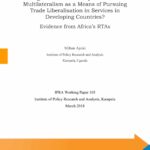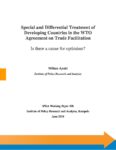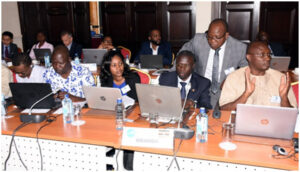The Institute has an exciting array of once-off and regular publications on key development policies, with emphasis on Sub-Saharan Africa. They include Books, African dialogue, research papers, working papers, occasional papers and economic reviews. The Institute’s publications communicate the analysis, views, and scholarship of their authors and are not intended to reflect an official view of the Institute or the views of members of the Institute’s Board of Trustees.
| Title | |
|---|---|
|
Domestic Revenue Mobilization and Reform of the Tax System in Burundi This book explores the link between tax reforms and revenue mobilization, and the options available for policy-makers on revenue mobilization in Burundi. It sets the current system in the context of reforms that have taken place over the last 30 years or so.
|
|
|
Domestic Revenue Mobilization and Reform of the Tax System in Namibia This bookexplores the link between tax reforms and revenue mobilization, and the options available for policy-makers on revenue mobilization in Namibia.It sets the current system in the context of reforms that have taken place over the last 30 years.
|
Download |
|
Taking stock of the tax reforms in Uganda, 1950–2018: Why tax exemptions should be avoided This book traces the tax policy and administrative measures that Uganda government has since introduced and implemented over the past six decades, and explains how the country fared under these reform episodes
|
Download |
|
The rise and fall of budget support in Africa This book provides a critical appraisal of budget support in Uganda since 1998- 2018, highlighting the socio political economy factors for the rise and fall of budget support. It explains why in the past years, support for GBS has diminished significantly among major bilateral donors. While some bilateral donorsreduced their GBS operations, others (formerly dedicated
|
Download |
|
Putting money in a basket with holes: a radical rethinking of the way to finance poverty reduction in Uganda This book explores ways in which donor agencies can avoid the pitfalls of basket funding to impact the lives of the poor in Uganda.
|
Download |
|
Public Expenditure Management Effectiveness in Uganda’s Education System This paper describes how the public education expenditure management system works in Uganda. It specifically identifies the formal roles of institutions; the structure and flow of information generated by the public expenditure management system and applies them to the Education Sector in Uganda. It shows the procedures for each stage in the expenditure and budget
|
Download |
This paper compares the gains from multilateral and regional trade liberalization in context of poverty reduction—whether multilateral liberalisation can be more successful in reducing poverty in Uganda than regionalism. Using a Computable General Equilibrium (CGE) framework and benchmark data from Uganda national household survey, the results show that poverty falls in all cases (under multilateral liberalisation and different regional integration arrangements), and but poverty falls much more under multilateral trade liberalisation.This paper compares the gains from multilateral and regional trade liberalization in context of poverty reduction—whether multilateral liberalisation can be more successful in reducing poverty in Uganda than regionalism. Using a Computable General Equilibrium (CGE) framework and benchmark data from Uganda national household survey, the results show that poverty falls in all cases (under multilateral liberalisation and different regional integration arrangements), and but poverty falls much more under multilateral trade liberalisation. |
||
This paper examines the approaches toliberalization of trade in services adopted within existing PTAs as compared to prevailing GATS’ commitments. The paper aims to gain a better understanding of whether and how the difficult issues associated with services trade and investment liberalisation are tackled in the PTA-type arrangement and how much further access is granted under PTAs. Using information and data from a selection of 30 PTAs most of them negotiated after 2000 (from Africa, Latin America, Asia, and Europe, among others), the paper establishes that most major PTAs are at the same pace with GATS in securing the rule-making interface between domestic regulation and trade in services. With exception of rules -making (safeguard mechanism, disciplines on subsidies or domestic regulation), where GATS prevails overall when considered in aggregate, PTAs appear to offer superior value added over GATS in all other areas. Across modes and sectors, PTA commitments tend to go significantly beyond GATS offers in terms of improved and new bindings. However, commitments on temporary movement of labour though superior in PTAs remain modest in scope. |
||
This paper examines the textile and clothing (T&C) industry in Lesotho to ascertain the initial effects of theend of quotas and other restrictions on global trade in textile and clothing.Results show a dramatic decline in Lesotho’s T&C exports, both in value terms and export share in major markets in industrialised countries: the U.S. and the EU in the aftermath of the Agreement on Textile and Clothing (ATC). The export decline for Lesotho and for Sub-Saharan African countries as a group has not been accompanied by simultaneous or rapid shift of increasing T&C exports by Asian developing countries, who continue toexport post-ATC at about the samelevels of textile and clothing that they did before ATC phase out. |
||
This paper analyses exports of textiles and clothing (T&C) from Sub-Saharan African countries in the decade leading to and after a phase out of the Agreement on Textile and Clothing (ATC) (Multi-fibre Agreement restrictions on T&C export)—from 1990s to 2016 using WTO and World Bank data sets—to ascertain the initial effects of the end of quotas and other restrictions on global trade in textile and clothing. Our results show a fall in exports of African countries in the aftermath of the ATC, and a simultaneous and gradual shift of increasing T&C exports by Asian countries (Asia & Pacific) into African markets at a much faster rate than their increase into the U.S. and EU markets. |
||
The focus on development adopted at the WTO’s Doha Ministerial Meeting in 2001 has changed the architecture of multilateral trade negotiations, with development issues assuming a central position in the WTO negotiation spaces and agreements. In this paper, we assess the extent to which the concerns of developing countries have been addressed in the TFA substantive provisions and special and differential treatment (S&DT) provisions for developing countries. We find that the TFA approach resembles a traditional approach to addressing concerns of developing countries and follows closely the already trodden path of the Uruguay S&DT discipline. An important cluster of issues that did not find its way into the TFA is that relating to regional approach in implementation of TFA. The TFA holds the promise of contributing positively to the development process in less developed countries if the promise of support is realized and developing countries set clear and objective targets to make effective use of the assistance, but in itself may not guarantee the realization of development objectives for developing and least developed countries. Provision of support and capacity building are unguranteed by nonbinding nature of the relevant provisions. This is the input that international partners could, and should, make to the realization of development objective of TFA. |
||
This paper offers an assessment of the status of services trade in Africa. It addresses three policy questions: how Africa has fared in trade in services trade over the past decade relative to other regions of the world; who the key players and partners are; and the sectors shaping Africa’s services trade. Africa’s trade in commercial services remains very concentrated in a few countries. Over the last 11 years (2006–2016) only three countries—Egypt, South Africa and Morocco accounted for 55.5 percent of Africa’s exports; and five countries—Nigeria, Angola, South Africa, Egypt and Algeria accounted for 55 percent of Africa’s imports). The implication is that conditions facing those countries will continue to influence Africa’s services landscape. Second, infrastructural constraints (including low rates of access to the Internet and poor connectivity) has hindered the participation of African economies in the most dynamicsegment of services trade leading to high export concentration (in very few sectors such as transport, tourism and travel-related services) heightening its vulnerability to external shocks. Third, with less than 10 percent of the value of services produced in most countries entering into the economy’s export basket, growth in services sector will continue to have very limited influence on the world market (share in global service exports). Reforms and programmes aimed at reducing trade barriers and cost of trading across borders (raised by inefficient transport, border management, and logistics, poorly designed technical regulations and standards, licensing requirements and process, among others) would not only create opportunities to directly expand services exports, but would also promote the development of competitive value chains of production across the region. |
||
This paper assessed the effectiveness of regional agreements (RTAs) in tackling many of the hurdles that potentially impede access to and presence in services markets. From the approaches and disciplines within the services trade frameworks and framework of the GATS, most major RTAs are at the same pace with GATS in securing the rule making interface between domestic regulation and trade in services, the necessity test, cross border trade in services, and mutual recognition and emergency safeguards and subsidies issues, but lag behind GATS in areas of policy sensitivities and handling of critical sectors such as telecommunication and financial services. As such, regionalism may not be a preferred means of pursuing trade liberalisation in sectors where policy sensitivities are high. Second, effective access to services markets and services exports performance involve interplay of a large number of policies measures, including those not typically falling within the scope to the services trade frameworks. Beyond reforms in services trade frameworks such as pursuing regional regulatory harmonization, Africa need to be alert to domestic policies and ensure that proper coordination exists with national officials in related policy areas. Third, entry restrictions and regulatory barriers retards growth of services exports sector as incumbent firms have no incentive to improve productivity to stay ahead of competition. |
||
The growing evidence of market failure, uncertainties in international cooperation and complexities of the problems of global inequalities has made special and differential treatment of developing countries (S&DT)not only increasingly necessary, but also increasingly difficult. In this paper, we examine the S&DT measures in the WTO Agreement on Trade Facilitation (TFA), in addressing the delicate balance between the concerns of developing countries and fostering the TFA’s objectives of expediting the movement, release and clearance of goods, including goods in transit. We find that,while the S&DT appears, in the face value, to offer flexibility for developing countries especially the least developed countries in implementation of the TFA, this flexibility has been eroded by conditioning assistance and support for capacity building to notification of commitments. The linking of support to commitment creates not only dilemma for developing countries on the timing of commitment (implementation) but also exposes them to risks of taking on increasing commitment before prerequisite capacity. Given the ‘best endeavour’ nature of the relevant provisions, it is not apparent that the benefits of implementing the Agreement will outweigh its costs if developed countries relegate on their promise to provide assistance and support for capacity building. |
||
For centuries, Europe has been an important market for products from Sub-Saharan Africa. In the turn of the twenty-first century, the boundary of the trade geography dramatically changed, with African products increasing going to the Gulf region. This provides evidence on the nature and evolution of trade between Uganda and the Gulf nations focusing on how African countries can build comparative advantages in sectors that yield significantly higher value added and are also less prone to price |
||
This paper investigates employment responses to trade liberalisation in a developing economy, Myanmar. Using data from the 2014 Census and the 2017, labour force survey and previous surveys contained in Myanmar Statistical Yearbook, 2017, we find that trade liberalization did not affect the relative size of industry sectors in terms of employment. The OLS results finds support for the theoretical predictions of differential responses to trade reforms between sectors. Conversely, while empirical support is found for tariff reduction in influencing sector level employment, the tariff predictors are weaker overall than the sector productivity and competitiveness (in export market) predictors—implying that trade policy reforms need to be correctly tailored to raising productivity of labour force and sector competitiveness if their impact on employment is to be effectively realised. |











